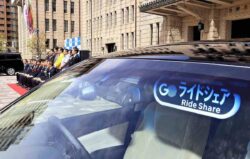Japan upgrades Q2 GDP as easing COVID curbs lift spending

A man takes a photo of a board displaying the Japanese yen exchange rate against the U.S. dollar outside a brokerage in Tokyo, Japan September 7, 2022.
10:23 JST, September 8, 2022
TOKYO (Reuters) – Japan’s economy grew more than initially reported in the second quarter, as the lifting of local COVID-19 restrictions boosted consumer and business spending.
That meant Japan saw its economy grow for a third quarter in April-June, even as worries about a slate of issues such as a global slowdown and high energy prices cloud the outlook.
Gross domestic product (GDP) in the world’s third-largest economy expanded an annualized 3.5% in the second quarter, stronger than the preliminary estimate of annualized 2.2% growth, government data showed Thursday.
The reading, which was better than a median market forecast for a 2.9% gain, equals a real quarter-on-quarter expansion of 0.9% from the prior quarter.
It suggested domestic demand staged a modest rebound after the government removed pandemic-related curbs on economic activity at the end of the first quarter.
Private consumption, which makes up more than half of the country’s GDP, grew 1.2%, the data showed, revised up from an initial estimate of a 1.1% increase.
Capital spending rose 2.0%, also revised up from a preliminary estimate of a 1.4% rise and more than a median market forecast for a 1.8% expansion, the data showed.
Domestic demand as a whole contributed 0.8 of a percentage point to revised GDP growth, while net exports added 0.1 of a percentage point.
Japan has lagged other major economies in shaking off the drag from the pandemic due to a slow consumption recovery, blamed partly on aging consumers who are reluctant to step up services spending over fears of COVID-19 infections.
Japan’s ultra loose monetary policy stands in stark contrast to a global wave of interest rate hikes, which has led to a sharp selloff in the yen, complicating the outlook for policymakers.
The slide in the Japanese currency, which has lost about 20% against the U.S. dollar over the past six months, is pushing up the cost of imports and raised the prospect that households will be forced to pay more for goods.






